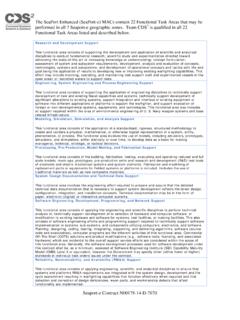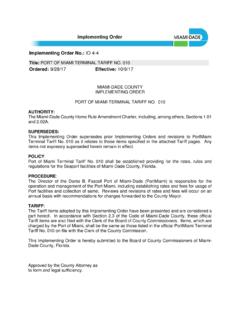Transcription of Bevin’s Skiff Building Manual Building Manual Introduction
1 Bevin s Skiff Building Manual 2012 Alexandria seaport Foundation 1 Building Manual Introduction Capacity The recommended capacity of Bevin s Skiff is 450 lbs (the capacity with 8" of freeboard) equivalent to 3, 150lb people. A Word on Safety- You're brought into this world with two eyes, two ears, ten fingers and ten toes, make sure you keep them. When you are using a tool, keep your hands behind the cutting edge of the blade. Use safety glasses, hearing protection and nitrile gloves. Most importantly, use common sense. It is your responsibility to know how to use your tools. If you don't know how to do something, ask someone who does.
2 This boat is designed to be easy to build, but nails can fly through the air when you try to hammer them. Hammering is noisy and polyurethane adhesive ( Sikaflex or 3M 4200/5200) is not totally benign. Epoxy can sensitize your skin and cause a rash. So be smart. Also be neat! Clean up squeezed out adhesive before it dries! Life (and painting) will be easier. A Word About This Manual The tone of this Manual reflects the importance we put on safety. When we say, "Don't Be Stupid!", we mean it (and we're talking from personal ) Read the directions all the way through before you start. Familiarize yourself with the pictures, drawings, parts list and tools/ supplies list.
3 Read the directions for each step all the way through- before you mark or cut the wood. These instructions are written to be used as you build this boat. If something is unclear, think about how the piece will fit in the boat. Build the cardstock model first. It s a good Introduction to how the boat parts fit together. It s available at both and the Building To Teach training website, where there is also access to hands on math training materials. To learn more Bevin s Skiff Building Manual 2012 Alexandria seaport Foundation 2 about Building To Teach, go to , You might read these instructions all the way through at the beginning and say, "I have no idea what he's talking about.
4 I'll never be able to build this. This isn't simple." Believe us, it is simple. A wonderful boat builder, Pete Culler, used to say, "Experience starts when you begin." So don't be afraid to get started. Remember, it's only a boat. A journey of 1,000 miles starts with one step. Videos Videos showing how to build a Bevin s Skiff and teach math are available at Look for Building To Teach. Even if you re not teaching math, the videos take you through the boat Building process. Building Technical Support We are available to answer questions about these boats, but remember, we're a small outfit! The best way is via E-Mail. Our address is You can reach us by phone, during US East Coast work hours, at 703 549 7078.
5 Kit Builders vs. Plan Builders Kit builders receive everything they need to build the boat when they buy a kit from the Alexandria seaport Foundation. Plan builders need to obtain all the materials and make all the boat parts. There are tools, materials list and material suppliers lists at the end of this Manual . Kit builders should also familiarize themselves with all the pieces before they get started. There will be several places in the Building process where plan builders will need to fabricate pieces and kit builders won't. Math Guide v. Building Instructions Bevin s Skiff was originally designed as a teaching tool. These instructions are also used for a Math Instructors Guide.
6 Each step is numbered with the Unit number first and the Building step number second, The order of the Building steps reflects the optimum method of teaching math while Building the boat. So, laying out and cutting the boat parts is the last unit. If you re a plan builder, you ll be doing that work first. Bevin s Skiff Building Manual 2012 Alexandria seaport Foundation 3 Epoxy and Polyurethane Adhesive You will be using two types of glue. Epoxy ( MAS) and a polyurethane adhesive ( ) . Neither likes to come out of clothes. There are golden rules for both. Epoxy Use in a warm place, 40 degrees F, or over Measure your resin and hardener accurately.
7 The ratio must be correct. Stir the resin/ hardener mix well for at least a minute before you add wood flour filler. Mix in the filler well for at least a minute. Don't mix until you need it and only mix a little more than you think you'll need. Read the manufacturer's instructions. You can clean up wet epoxy from your hands and tools with ordinary household white vinegar or "GOJO" hand cleaner. Polyurethane Use in a warm place, 40 degrees F and over. Make sure you remove the metal cap from the rear of the tube, if there is one, and cut the nozzle and punch a hole in the nozzle seal with a 16d nail, or other long pointed object.
8 Release the pressure in the calking gun after each use. Otherwise more adhesive will end up on the floor than in the boat. Let's Get To It! Bevin s Skiff Building Manual 2012 Alexandria seaport Foundation 4 Glossary Tool Terms Bevel Board A board on which needed angles, or bevels, are marked Bevel Gauge A tool with a body and a movable blade that usually can be locked into position. It s used to transfer angles from one object to another, from the boat to a piece of wood. Also known as a sliding tee bevel Bucking Iron A small heavy mass, usually a big hammerhead, used to support a piece as it is being nailed Carpenter s Scribers A simple compass.
9 Used for scribing marking a piece of wood to fit it against another surface. Similar to a compass used for drafting and mechanical drawing Carpenter s Square A flat 90 degree square with ruler scales on each edge of both sides. The scales can include 1/8ths , 1/16ths , 1/12ths , 1/10th and 1/100ths . The long leg , 24 x 2 ,is the body. The shorter leg , 16 x 1 , is the tongue. The front surface is the face. The opposite surface is the back. Most squares have tables printed on the face and back that can be used to calculate rafter lengths, board footage, brace lengths and measurements necessary to eight side a timber. Square features vary by manufacturer and model.
10 Also known as a framing square. Stanley 45-011 or Empire e1190 are typical complete squares. Clamping Pad Disposable piece of wood used to spread the clamping pressure and protect the finished wood Combination Square A square with a 12 sliding ruler, level and usually a scribe for scratching marks. Can be used to create either 90 degree or 45 degree angles. Can also be used as a depth, or marking, gauge. Hand Saw You want to use a cross cut saw, rather than a rip saw. There are two styles, Western and Japanese. Both styles work well- when sharp. Japanese saws are thinner and cut on the pull stroke. They cut faster, but can be bent easier Bevin s Skiff Building Manual 2012 Alexandria seaport Foundation 5 than a Western blade.


